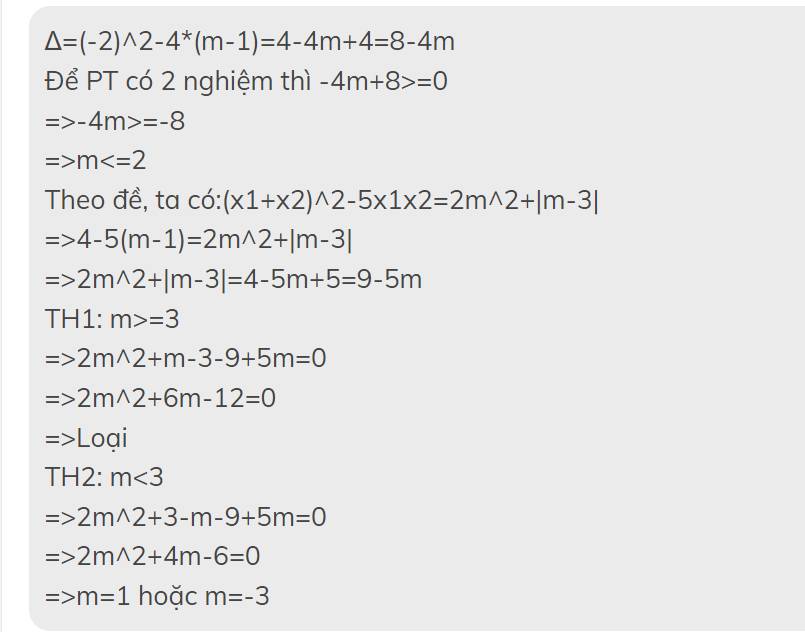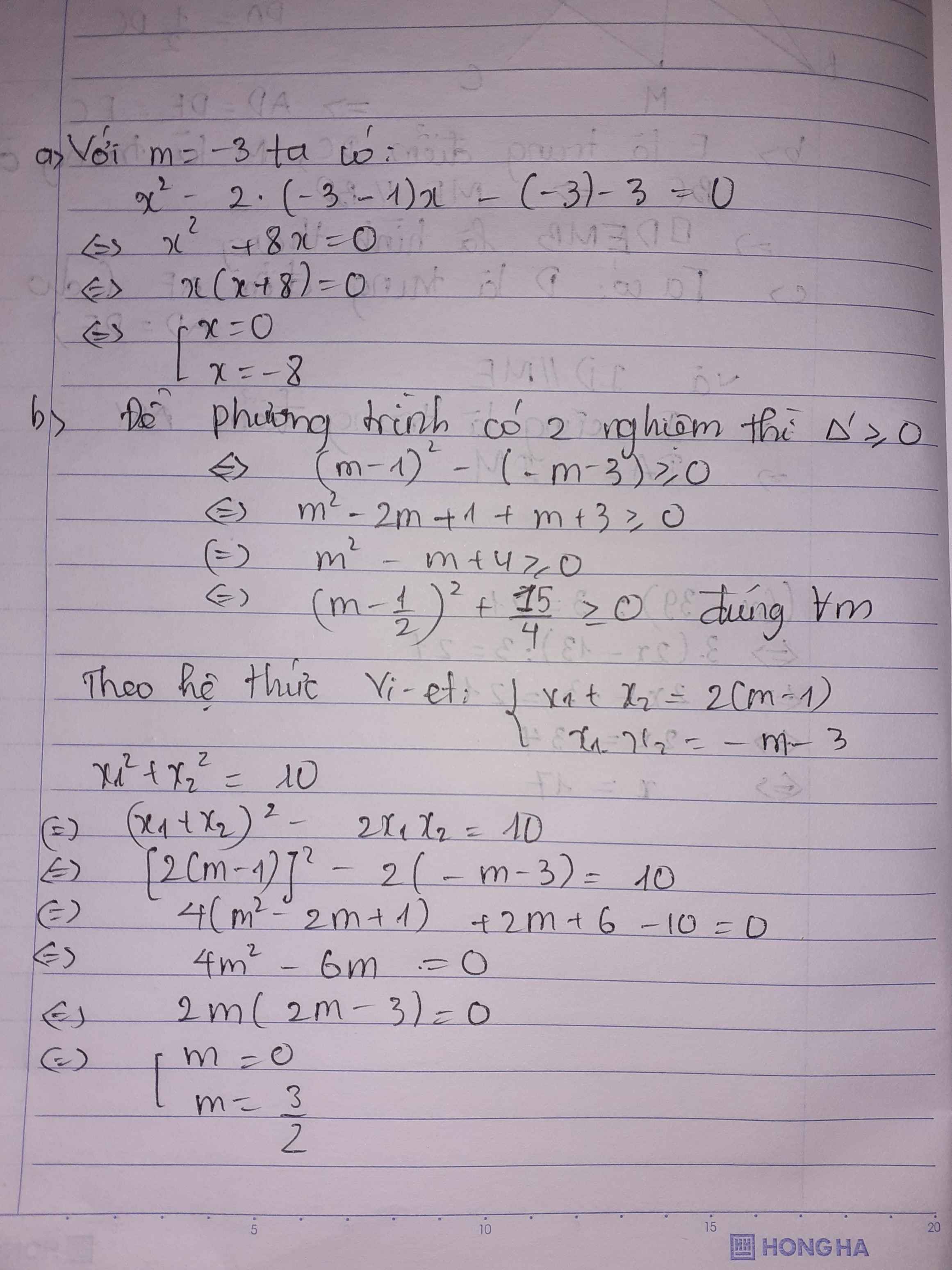
Hãy nhập câu hỏi của bạn vào đây, nếu là tài khoản VIP, bạn sẽ được ưu tiên trả lời.


a, \(\Delta=\left(-m\right)^2-4\left(-2\right)=m^2+8>0\forall m\in R\)
\(\Rightarrow\) Phương trình có 2 nghiệm phân biệt \(\forall m\)
b, Theo vi-lét ta có: \(x_1+x_2=m\) và \(x_1x_2=-2\)
Ta có: \(x^2_1+x^2_2-3x_1x_2=14\)
\(\Leftrightarrow\left(x_1+x_2\right)^2-5x_1x_2=14\)
\(\Leftrightarrow m^2+10=14\)
\(\Leftrightarrow m^2=4\)
\(\Leftrightarrow m=\pm2\)
Vậy .............

\(\Delta=m^2+8\ge8\forall m\)
=> \(\Delta>0\)=> PT có 2 nghiệm phân biệt với mọi m
Theo Vi-et ta có: \(\hept{\begin{cases}x_1+x_2=m\\x_1x_2=-2\end{cases}}\)
\(x_1^2+x_2^2-3x_1x_2=14\)
\(\Leftrightarrow\left(x_1+x_2\right)^2-5x_1x_2=14\)
\(\Leftrightarrow m^2=14-10=4\)
\(\Leftrightarrow m=\pm2\)

Áp dụng hệ thức Vi-ét,ta có :
\(\hept{\begin{cases}x_1+x_2=m\\x_1x_2=-2\end{cases}}\)
Ta có : \(x_1^2+x_2^2-3x_1x_2=14\Leftrightarrow\left(x_1+x_2\right)^2-5x_1x_2=14\)
\(\Leftrightarrow m^2+10=14\Rightarrow m^2=4\Rightarrow m=\pm2\)
Theo vi-ét \(\hept{\begin{cases}x_1+x_2=\frac{-b}{a}=m\\x_1.x_2=\frac{c}{a}=-2\end{cases}}\)
Thay vào ta có : \(x_1^2+x_2^2-3.x_1.x_2=14\)
\(< =>x_1^2+2.x_1.x_2+x_2^2-5.x_1.x_2=14\)
\(< =>\left(x_1+x_2\right)^2-5.x_1.x_2=14\)
\(< =>m^2-5.\left(-2\right)=m^2+10=14< =>\orbr{\begin{cases}m=2\\m=-2\end{cases}}\)
Cách mình ko khác anh Tùng tí nào đâu

\(\Delta'=\left[-\left(m+4\right)\right]^2-1\left(m^2-8\right)=m^2+8m+16-m^2+8=8m+24\)
Để pt có 2 nghiệm thì \(\Delta'\ge0\Leftrightarrow8m+24\ge0\Leftrightarrow m\ge-3\)
Áp dụng định lý Vi-ét ta có:\(\left\{{}\begin{matrix}x_1+x_2=2m+8\\x_1x_2=m^2-8\end{matrix}\right.\)
\(A=x^2_1+x^2_2-x_1-x_2\\ =\left(x_1+x_2\right)^2-2x_1x_2-\left(x_1+x_2\right)\\ =\left(2m+8\right)^2-2\left(m^2-8\right)-\left(2m+8\right)\\ =4m^2+32m+64-2m^2+16-2m-16\\ =2m^2+30m+64\)
Amin=\(-\dfrac{97}{2}\)\(\Leftrightarrow m=-\dfrac{15}{2}\)
\(B=x^2_1+x^2_2-x_1x_2\\ =\left(x_1+x_2\right)^2-3x_1x_2\\ =\left(2m+8\right)^2-3\left(m^2-8\right)\\ =4m^2+32m+64-3m^2+24\\ =m^2+32m+88\)
Bmin=-168\(\Leftrightarrow\)m=-16

Giả sử ta định m sao cho pt \(x^2-mx+m-1=0\left(1\right)\) luôn có nghiệm.
Theo định lí Viet ta có: \(\left\{{}\begin{matrix}x_1+x_2=m\\x_1x_2=m-1\end{matrix}\right.\)
\(C=\dfrac{2x_1x_2+3}{x_1^2+x_2^2+2\left(x_1x_2+1\right)}=\dfrac{2x_1x_2+3}{\left(x_1+x_2\right)^2+2}=\dfrac{2\left(m-1\right)+3}{m^2+2}=\dfrac{2m+1}{m^2+2}\)
\(\Rightarrow C\left(m^2+2\right)=2m+1\Rightarrow Cm^2-2m+\left(2C+1\right)=0\left(2\right)\)
Coi phương trình (2) là phương trình ẩn m tham số C, ta có:
\(\Delta'=1^2-C.\left(2C+1\right)=-2C^2-C+1\)
Để phương trình (2) có nghiệm thì:
\(\Delta'\ge0\Rightarrow-2C^2-C+1\ge0\)
\(\Leftrightarrow\left(2C-1\right)\left(C+1\right)\le0\)
\(\Leftrightarrow-1\le C\le\dfrac{1}{2}\)
Vậy \(MinC=-1;MaxC=\dfrac{1}{2}\)

1.
\(a+b+c=0\) nên pt luôn có 2 nghiệm
\(\left\{{}\begin{matrix}x_1+x_2=m\\x_1x_2=m-1\end{matrix}\right.\)
\(A=\dfrac{2x_1x_2+3}{x_1^2+x_2^2+2x_1x_2+2}=\dfrac{2x_1x_2+3}{\left(x_1+x_2\right)^2+2}=\dfrac{2\left(m-1\right)+3}{m^2+2}=\dfrac{2m+1}{m^2+2}\)
\(A=\dfrac{m^2+2-\left(m^2-2m+1\right)}{m^2+2}=1-\dfrac{\left(m-1\right)^2}{m^2+2}\le1\)
Dấu "=" xảy ra khi \(m=1\)
2.
\(\Delta=m^2-4\left(m-2\right)=\left(m-2\right)^2+4>0;\forall m\) nên pt luôn có 2 nghiệm pb
Theo Viet: \(\left\{{}\begin{matrix}x_1+x_2=m\\x_1x_2=m-2\end{matrix}\right.\)
\(\dfrac{\left(x_1^2-2\right)\left(x_2^2-2\right)}{\left(x_1-1\right)\left(x_2-1\right)}=4\Rightarrow\dfrac{\left(x_1x_2\right)^2-2\left(x_1^2+x_2^2\right)+4}{x_1x_2-\left(x_1+x_2\right)+1}=4\)
\(\Rightarrow\dfrac{\left(x_1x_2\right)^2-2\left(x_1+x_2\right)^2+4x_1x_2+4}{x_1x_2-\left(x_1+x_2\right)+1}=4\)
\(\Rightarrow\dfrac{\left(m-2\right)^2-2m^2+4\left(m-2\right)+4}{m-2-m+1}=4\)
\(\Rightarrow-m^2=-4\Rightarrow m=\pm2\)

a) Với m = -3 phương trình trở thành
\(x^2+8x=0\\ \Leftrightarrow x\left(x+8\right)=0\\ \Leftrightarrow\left[{}\begin{matrix}x=0\\x=-8\end{matrix}\right.\)
Vậy phương trình có tập nghiệm \(S=\left\{0;-8\right\}\)
b. Xét phương trình \(x^2-2\left(m-1\right)x-m-3=0\)
\(\Delta'=\left(m-1\right)^2-\left(-m-3\right)=m^2-2m+1+m+3=m^2-m+4=\left(m-\dfrac{1}{2}\right)^2+\dfrac{15}{4}>0\)
Suy ra, phương trình có 2 nghiệm \(x_1,x_2\) thỏa mãn \(\left\{{}\begin{matrix}x_1+x_2=2\left(m-1\right)\\x_1x_2=-m-3\end{matrix}\right.\) (hệ thức Viet)
Ta có :
\(x_1^2+x_2^2=10\\ \Leftrightarrow\left(x_1+x_2\right)^2-2x_1x_2=10\\ \Leftrightarrow4\left(m-1\right)^2+2\left(m+3\right)=10\\ \Leftrightarrow4m^2-6m=0\\ \Leftrightarrow\left[{}\begin{matrix}m=0\\m=\dfrac{3}{2}\end{matrix}\right.\)
Vậy \(m\in\left\{0;\dfrac{3}{2}\right\}\)




Vi-ét\(\hept{\begin{cases}x_1+x_2=m\\x_1x_2=-2\end{cases}}\)
\(x_1^2+x_2^2-3x_1x_2=14\)
\(\Leftrightarrow\left(x_1+x_2\right)^2-5x_1x_2=14\)
\(\Leftrightarrow m^2=14-10\)
\(\Leftrightarrow m=\pm2\)